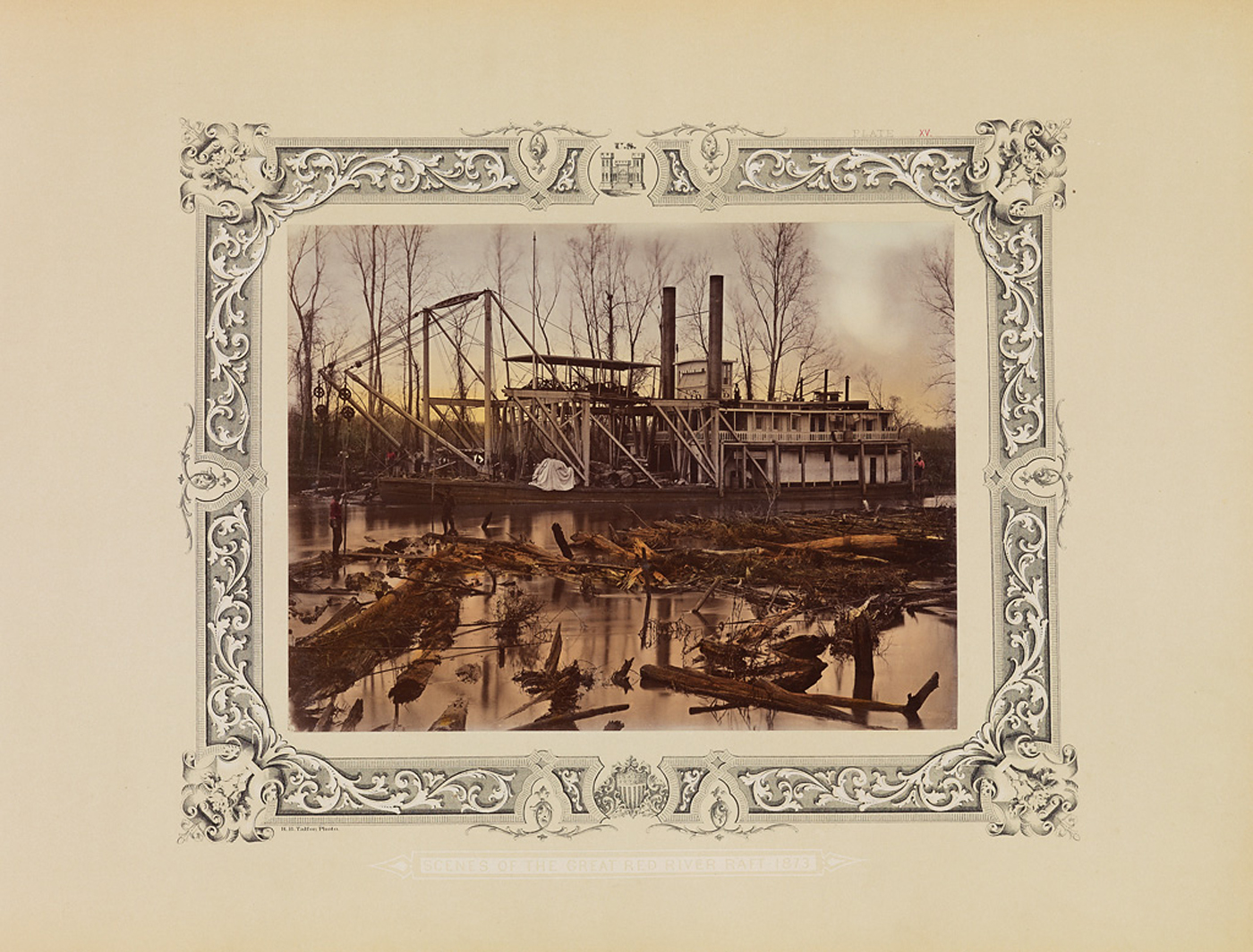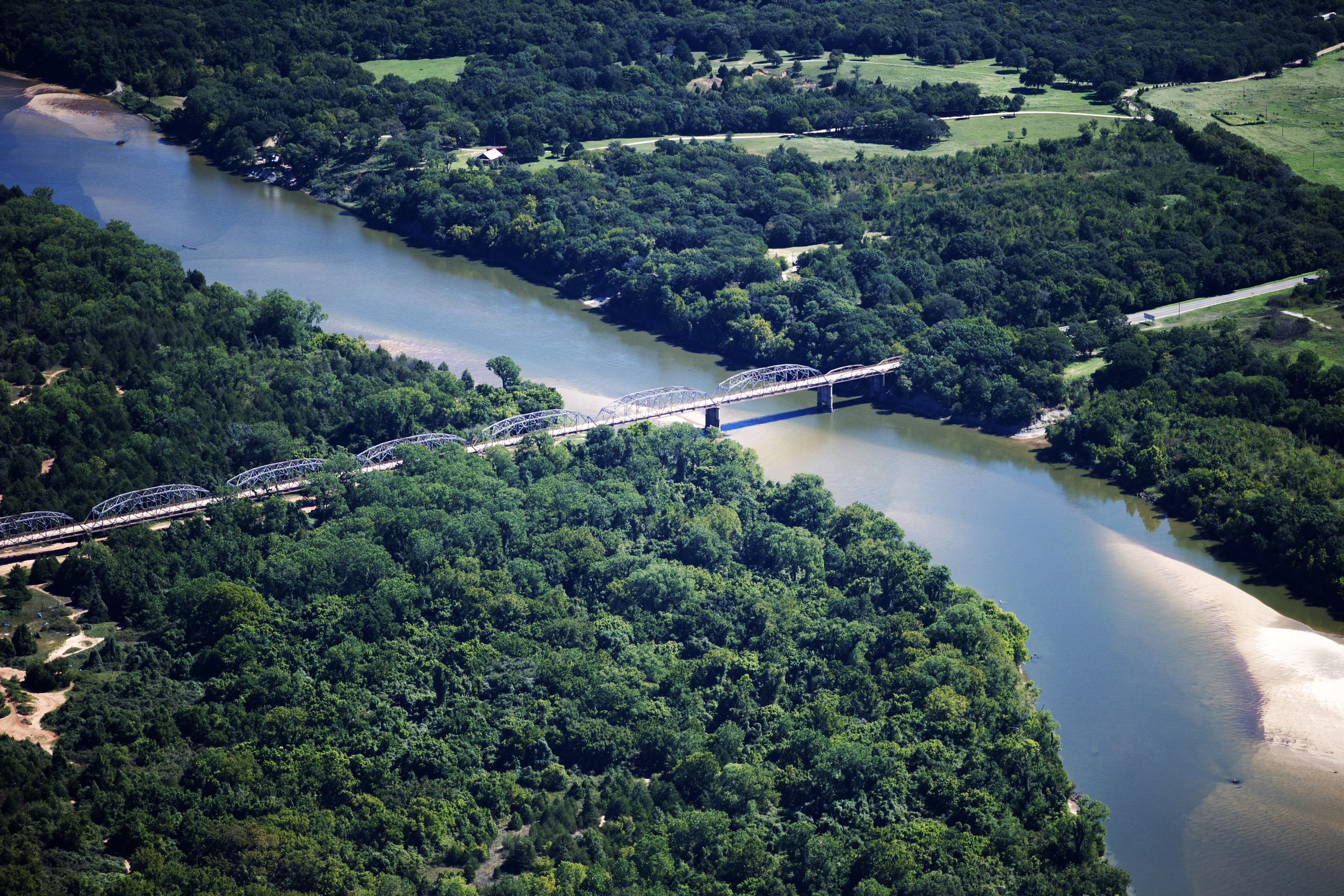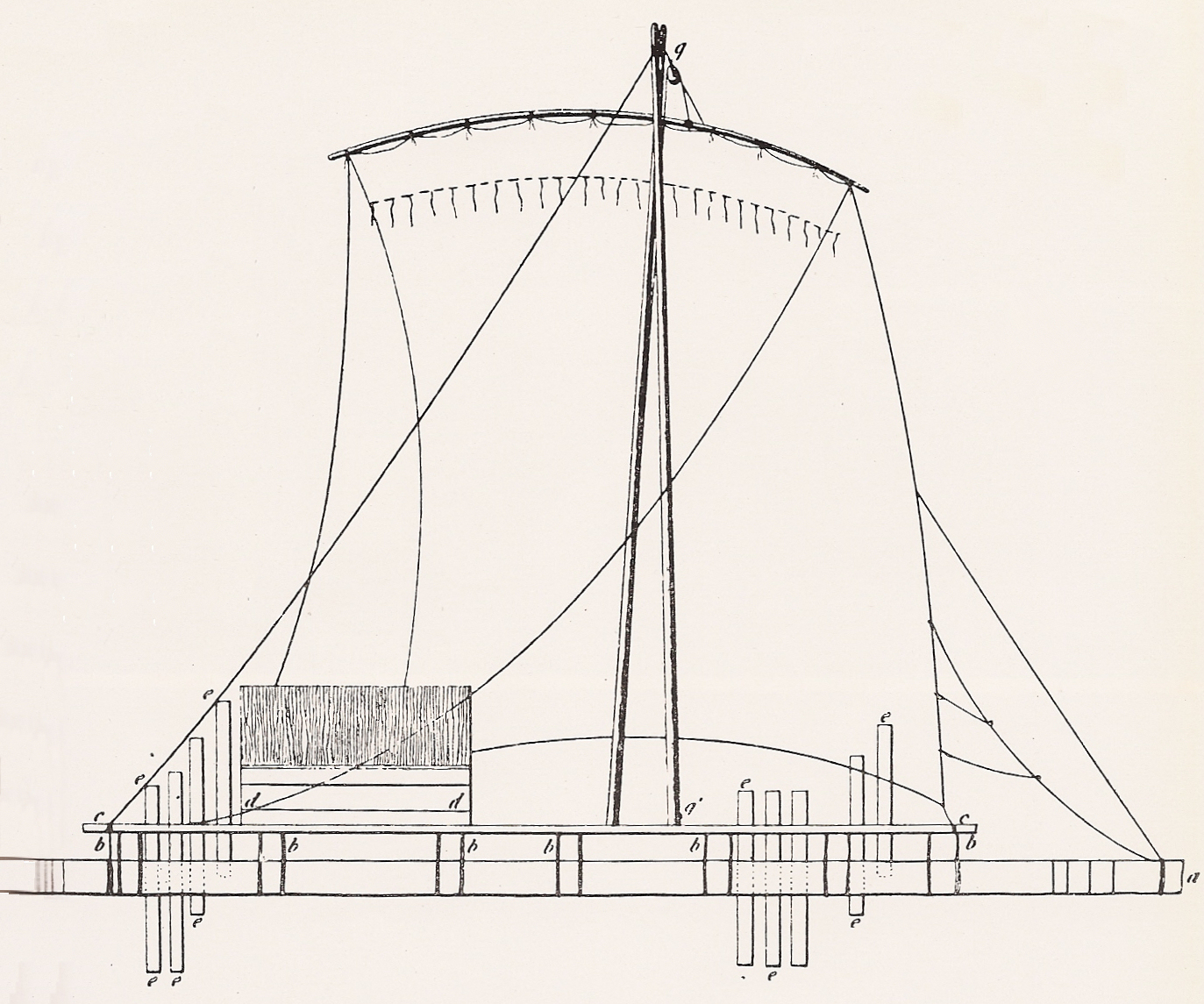|
Great Raft
The Great Raft was a gigantic log jam or series of " rafts" that clogged the Red and Atchafalaya rivers and was unique in North America in terms of its scale. Origin The Great Raft probably began forming in the 12th century. It grew from its upper end, while decaying or washing out at the lower end. By the early 1830s, it spanned more than . The raft, at one point, extended for from Loggy Bayou to Carolina Bluffs. Because of its scale, the Great Raft became incorporated in the mythology of the regional Caddo tribe, which had been in the area for thousands of years. They credited it with protecting them from competing tribes, as well as intermittently causing floods on the land and making it fertile for agriculture. Harrelson et al. describe the origins of the raft: This ecosystem of entangled logs, vegetation and sediments remained in place for almost two millennia, altering the flow regime of the Red River and causing a complete change in its geomorphic character from a ... [...More Info...] [...Related Items...] OR: [Wikipedia] [Google] [Baidu] |
Red River Of The South
The Red River, or sometimes the Red River of the South, is a major river in the Southern United States. It was named for its reddish water color from passing through red-bed country in its watershed. It is one of several rivers with that name. Although once a tributary of the Mississippi River, the Red River is now a tributary of the Atchafalaya River, a distributary of the Mississippi that flows separately into the Gulf of Mexico. This confluence is connected to the Mississippi River by the Old River Control Structure. The south bank of the Red River formed part of the US–Mexico border from the Adams–Onís Treaty (in force 1821) until the Texas Annexation and the Treaty of Guadalupe Hidalgo. The Red River is the second-largest river basin in the southern Great Plains. It rises in two branches in the Texas Panhandle and flows east, where it serves as the border between the states of Texas and Oklahoma. It forms a short border between Texas and Arkansas before enteri ... [...More Info...] [...Related Items...] OR: [Wikipedia] [Google] [Baidu] |
Photographic Views Of Red River Raft 14
Photography is the art, application, and practice of creating durable images by recording light, either electronically by means of an image sensor, or chemically by means of a light-sensitive material such as photographic film. It is employed in many fields of science, manufacturing (e.g., photolithography), and business, as well as its more direct uses for art, film and video production, recreational purposes, hobby, and mass communication. Typically, a lens is used to focus the light reflected or emitted from objects into a real image on the light-sensitive surface inside a camera during a timed exposure. With an electronic image sensor, this produces an electrical charge at each pixel, which is electronically processed and stored in a digital image file for subsequent display or processing. The result with photographic emulsion is an invisible latent image, which is later chemically "developed" into a visible image, either negative or positive, depending on the purpose ... [...More Info...] [...Related Items...] OR: [Wikipedia] [Google] [Baidu] |
Rafts
A raft is any flat structure for support or transportation over water. It is usually of basic design, characterized by the absence of a hull. Rafts are usually kept afloat by using any combination of buoyant materials such as wood, sealed barrels, or inflated air chambers (such as pontoons), and are typically not propelled by an engine. Rafts are an ancient mode of transport; naturally-occurring rafts such as entwined vegetation and pieces of wood have been used to traverse water since the dawn of humanity. Human-made rafts Traditional or primitive rafts were constructed of wood or reeds. Modern rafts may also use pontoons, drums, or extruded polystyrene blocks. Inflatable rafts up to the 20th century used flotation chambers made of goat- or buffalo-skins, but most now use durable, multi-layered rubberized fabrics. Depending on its use and size, it may have a superstructure, masts, or rudders. Timber rafting is used by the logging industry for the transportation of logs, ... [...More Info...] [...Related Items...] OR: [Wikipedia] [Google] [Baidu] |
History Of Shreveport, Louisiana
Shreve Town was originally contained within the boundaries of a section of land sold to the company by the indigenous Caddo Indians in the year of 1835, during the period of Indian Removal.Plummer, Marguerite R. & Joiner, Gary D. (2000)''Historic Shreveport-Bossier: An Illustrated History of Shreveport and Bossier City'' pp. 11–12. Historical Publishing Network. In 1838, Caddo Parish was created from the large Natchitoches Parish (pronounced "NACK-a-dish") and Shreve Town was designated as the parish seat. Shreveport remains the parish seat of Caddo Parish today. On March 20, 1839, the town was incorporated as "Shreveport". 1900 to present Shreveport was home to the '' Louisiana Hayride'', a radio broadcast from the city's Municipal Auditorium. During its heyday from 1948 to 1960, it featured musicians who became noted nationally, such as Hank Williams, Sr., and Elvis Presley (who got his start at this venue). The city and region suffered during and after the decline ... [...More Info...] [...Related Items...] OR: [Wikipedia] [Google] [Baidu] |
Natural History Of Texas
Nature, in the broadest sense, is the physical world or universe. "Nature" can refer to the phenomena of the physical world, and also to life in general. The study of nature is a large, if not the only, part of science. Although humans are part of nature, human activity is often understood as a separate category from other natural phenomena. The word ''nature'' is borrowed from the Old French ''nature'' and is derived from the Latin word ''natura'', or "essential qualities, innate disposition", and in ancient times, literally meant "birth". In ancient philosophy, ''natura'' is mostly used as the Latin translation of the Greek word ''physis'' (φύσις), which originally related to the intrinsic characteristics of plants, animals, and other features of the world to develop of their own accord. The concept of nature as a whole, the physical universe, is one of several expansions of the original notion; it began with certain core applications of the word φύσις by pre-Socr ... [...More Info...] [...Related Items...] OR: [Wikipedia] [Google] [Baidu] |
History Of Louisiana
The history of the area that is now the U.S. state of Louisiana, can be traced back thousands of years to when it was occupied by indigenous peoples. The first indications of permanent settlement, ushering in the Archaic period, appear about 5,500 years ago. The area that is now Louisiana formed part of the Eastern Agricultural Complex. The Marksville culture emerged about 2,000 years ago out of the earlier Tchefuncte culture. It is considered ancestral to the Natchez and Taensa peoples. Around the year 800 AD, the Mississippian culture emerged from the Woodland period. The emergence of the Southeastern Ceremonial Complex coincides with the adoption of maize agriculture and chiefdom-level complex social organization beginning in circa 1200 AD. The Mississippian culture mostly disappeared around the 16th century, with the exception of some Natchez communities that maintained Mississippian cultural practices into the 1700s. European influence began in the 1500s, and '' La Lou ... [...More Info...] [...Related Items...] OR: [Wikipedia] [Google] [Baidu] |
Old River Control Structure
The Old River Control Structure is a floodgate system in a branch of the Mississippi River in central Louisiana. It regulates the flow of water from the Mississippi into the Atchafalaya River, thereby preventing the Mississippi River from changing course. Completed in 1963, the complex was built by the U.S. Army Corps of Engineers in a side channel of the Mississippi known as "Old River", between the Mississippi's current channel and the Atchafalaya Basin, a former channel of the Mississippi. The Old River Control Structure is a complex containing the original low-sill and overbank structures, as well as the auxiliary structure that was constructed after the low-sill structure was damaged during the Mississippi River Flood of 1973. The complex also contains a navigation lock and the Sidney A. Murray Jr. Hydroelectric Station. Old River Before the 15th century, the Red River and Mississippi River were entirely separate and flowed more or less parallel to one another. ... [...More Info...] [...Related Items...] OR: [Wikipedia] [Google] [Baidu] |
US Army Corps Of Engineers
, colors = , anniversaries = 16 June (Organization Day) , battles = , battles_label = Wars , website = , commander1 = Lieutenant general (United States), LTG Scott A. Spellmon , commander1_label = List of United States Army Corps of Engineers Chiefs of Engineers, Chief of Engineers and Commanding General of the U.S. Army Corps of Engineers , commander2 = Major general (United States), MG]Richard J. Heitkamp, commander2_label = Deputy Chief of Engineers and Deputy Commanding General , commander3 = Major general (United States), MGKimberly M. Colloton, commander3_label = Deputy Commanding General for Military and International Operations , commander4 = Major general (United States), MG]William H. Graham, commander4_label = Deputy Command ... [...More Info...] [...Related Items...] OR: [Wikipedia] [Google] [Baidu] |
Gulf Of Mexico
The Gulf of Mexico ( es, Golfo de México) is an ocean basin and a marginal sea of the Atlantic Ocean, largely surrounded by the North American continent. It is bounded on the northeast, north and northwest by the Gulf Coast of the United States; on the southwest and south by the Mexican states of Tamaulipas, Veracruz, Tabasco, Campeche, Yucatan, and Quintana Roo; and on the southeast by Cuba. The Southern U.S. states of Texas, Louisiana, Mississippi, Alabama, and Florida, which border the Gulf on the north, are often referred to as the " Third Coast" of the United States (in addition to its Atlantic and Pacific coasts). The Gulf of Mexico took shape approximately 300 million years ago as a result of plate tectonics.Huerta, A.D., and D.L. Harry (2012) ''Wilson cycles, tectonic inheritance, and rifting of the North American Gulf of Mexico continental margin.'' Geosphere. 8(1):GES00725.1, first published on March 6, 2012, The Gulf of Mexico basin is roughly ov ... [...More Info...] [...Related Items...] OR: [Wikipedia] [Google] [Baidu] |
Distributary
A distributary, or a distributary channel, is a stream that branches off and flows away from a main stream channel. Distributaries are a common feature of river deltas. The phenomenon is known as river bifurcation. The opposite of a distributary is a tributary, which flows ''towards'' and joins another stream. Distributaries are often found where a stream approaches a lake or an ocean. They can also occur inland, on alluvial fans, or where a tributary stream bifurcates as it nears its confluence with a larger stream. In some cases, a minor distributary can divert so much water from the main channel that it can later become the main route. Related terms Common terms to name individual river distributaries in English-speaking countries are ''arm'' and ''channel''. These terms may refer to a distributary that does not rejoin the channel from which it has branched (e.g., the North, Middle, and South Arms of the Fraser River, or the West Channel of the Mackenzie River), or to on ... [...More Info...] [...Related Items...] OR: [Wikipedia] [Google] [Baidu] |
Mississippi River
The Mississippi River is the second-longest river and chief river of the second-largest drainage system in North America, second only to the Hudson Bay drainage system. From its traditional source of Lake Itasca in northern Minnesota, it flows generally south for to the Mississippi River Delta in the Gulf of Mexico. With its many tributaries, the Mississippi's watershed drains all or parts of 32 U.S. states and two Canadian provinces between the Rocky and Appalachian mountains. The main stem is entirely within the United States; the total drainage basin is , of which only about one percent is in Canada. The Mississippi ranks as the thirteenth-largest river by discharge in the world. The river either borders or passes through the states of Minnesota, Wisconsin, Iowa, Illinois, Missouri, Kentucky, Tennessee, Arkansas, Mississippi, and Louisiana. Native Americans have lived along the Mississippi River and its tributaries for thousands of years. Most were ... [...More Info...] [...Related Items...] OR: [Wikipedia] [Google] [Baidu] |
Arkansas
Arkansas ( ) is a landlocked state in the South Central United States. It is bordered by Missouri to the north, Tennessee and Mississippi to the east, Louisiana to the south, and Texas and Oklahoma to the west. Its name is from the Osage language, a Dhegiha Siouan language, and referred to their relatives, the Quapaw people. The state's diverse geography ranges from the mountainous regions of the Ozark and Ouachita Mountains, which make up the U.S. Interior Highlands, to the densely forested land in the south known as the Arkansas Timberlands, to the eastern lowlands along the Mississippi River and the Arkansas Delta. Arkansas is the 29th largest by area and the 34th most populous state, with a population of just over 3 million at the 2020 census. The capital and most populous city is Little Rock, in the central part of the state, a hub for transportation, business, culture, and government. The northwestern corner of the state, including the Fayetteville� ... [...More Info...] [...Related Items...] OR: [Wikipedia] [Google] [Baidu] |




.jpg)




